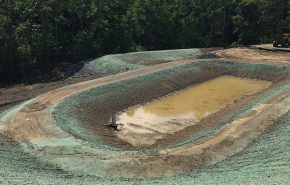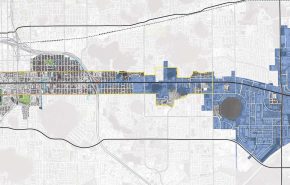New GIS technology developments hold substantial promise for GAI clients. GAI Assistant GIS Technical Leader Michael Owens, GISP shares some standout enhancements.
Some 20,000 attendees explored the latest advancements in GIS technology at the 2018 Environmental Systems Research Institute (Esri) User Conference held July 9-13 in San Diego, CA, among them Michael Owens, GISP, GAI Assistant GIS Technical Leader.
“The Esri conference was a terrific opportunity to network with fellow GIS specialists and gather in-depth insight into developing GIS capabilities,” said Owens. “These improvements and enhancements will help boost efficiencies in GAI’s workspace and lead to better, more efficient project delivery for our clients.”
GIS Technology and How It Works at GAI
GIS is a computer-based system that collects, integrates, and analyzes diverse data and generates information-rich maps of a given geographical area. Esri is the world’s leading developer and supplier of GIS systems and software.
At GAI, GIS technology has a range of applications in energy, development, planning, and cultural resources projects. Integrating a wealth of data like population, topography, environmental, structures, permitting, roads, and more, GIS maps help engineers and clients make informed decisions that lead to sustainable solutions.
GIS Technology Gains Powerful Vision
One development that stood out for Owens was Esri’s integration of virtual and augmented reality into their GIS technology.
While GIS maps now offer data-rich representations of a specified geographic area, virtual and augmented reality will offer greatly enhanced ways to visualize that data. Owens noted the promise of virtual/augmented reality GIS in guiding firefighters and EMTs through structures during emergency response situations, and pointed to benefits that the combination of GIS and virtual/augmented reality presents to energy sector and other utilities.
When work needs to be performed and services need to be located in the field, augmented reality puts the engineer “inside the map.”
“Utility companies worldwide rely on GIS to manage and map their overhead and underground facilities—but the majority of this data is represented in 2-D,” said Owens. “When work needs to be performed and services need to be located in the field, augmented reality puts the engineer ‘inside the map,’ which presents a more accurate representation of where layered, intersecting services from all area utilities are located relative to one another. Beyond helping work proceed more quickly and efficiently, 3-D augmented reality GIS visualization helps mitigate possible damage to adjacent services.”
More emerging GIS tools, advancements, and topics explored during the Esri conference include:
- Advancements in Urban Planning & Development
ArcGIS Urban provides a common GIS-based solution for planners, architects, developers, and citizens. Conference demonstrations of ArcGIS Urban highlighted rapid visual analyses of population growth/trends and shadow studies, site-development suitability models, re-zoning workflows and zoning code integration, and interactive three-dimensional cityscape visualizations and modeling. - A Business Case for Machine Learning & Artificial Intelligence
An enhanced set of geoprocessing tools uses machine learning and artificial intelligence (AI) to streamline the process of site-selection modeling. The enhanced tools enrich GIS data with business and census information to classify and analyze business districts, and to predict the trends and business needs of various neighborhoods around a city or region. - Enhanced ArcGIS Network Management Solution for Utilities
Esri demonstrated how an electrical utility company might use the ArcGIS Network Management solution to help boost safety, efficiency, and reliability. Using GIS, utilities can build schematic maps that trace the path of electricity from the substation to the customer—this facilitates quick and efficient de-energization of distribution lines at the switch/order level, allowing for safe repair or maintenance work while affecting as few customers as possible.
Contact Michael Owens, GISP, to find out more about the latest advances in GIS technology, and how GAI puts GIS to work for a range of energy, infrastructure, and planning projects.
![]() Assistant GIS Technical Leader Michael Owens, GISP is GAI’s Practice Area Leader for GIS in the Northeast region. He is primary GIS Project Manager for GAI’s Energy unit, and plays a significant role in projects that require advanced GIS technical skills. Mike is responsible for maintaining and improving GIS quality standards, optimizing GIS software/hardware deployments, advancing GIS use with internal and external clients, and attending local and regional GIS seminars and conferences to help ensure that GAI is servicing our clients using the latest applicable technology and best practices.
Assistant GIS Technical Leader Michael Owens, GISP is GAI’s Practice Area Leader for GIS in the Northeast region. He is primary GIS Project Manager for GAI’s Energy unit, and plays a significant role in projects that require advanced GIS technical skills. Mike is responsible for maintaining and improving GIS quality standards, optimizing GIS software/hardware deployments, advancing GIS use with internal and external clients, and attending local and regional GIS seminars and conferences to help ensure that GAI is servicing our clients using the latest applicable technology and best practices.


